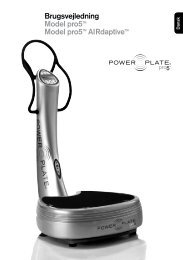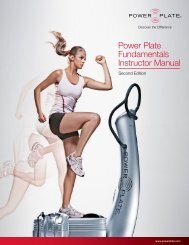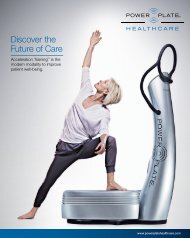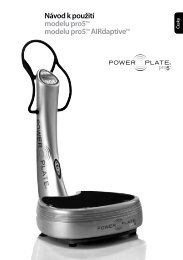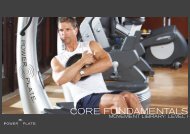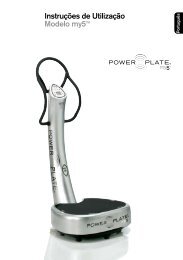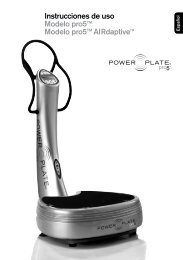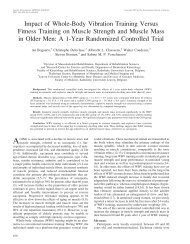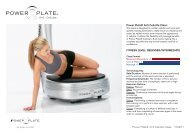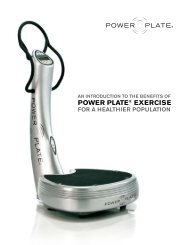Effect of Vibration on Forward Split Flexibility and Pain ... - Power Plate
Effect of Vibration on Forward Split Flexibility and Pain ... - Power Plate
Effect of Vibration on Forward Split Flexibility and Pain ... - Power Plate
Create successful ePaper yourself
Turn your PDF publications into a flip-book with our unique Google optimized e-Paper software.
Internati<strong>on</strong>al Journal <str<strong>on</strong>g>of</str<strong>on</strong>g> Sports Physiology <strong>and</strong> Performance, 2008, 3, 469-481<br />
© 2008 Human Kinetics, Inc.<br />
<str<strong>on</strong>g>Effect</str<strong>on</strong>g> <str<strong>on</strong>g>of</str<strong>on</strong>g> <str<strong>on</strong>g>Vibrati<strong>on</strong></str<strong>on</strong>g> <strong>on</strong> <strong>Forward</strong> <strong>Split</strong><br />
<strong>Flexibility</strong> <strong>and</strong> <strong>Pain</strong> Percepti<strong>on</strong><br />
in Young Male Gymnasts<br />
William A. S<strong>and</strong>s, Jeni R. McNeal, Michael H. St<strong>on</strong>e,<br />
G. Gregory Haff, <strong>and</strong> Ann M. Kinser<br />
Serious stretching in many sports involves discomfort <strong>and</strong> is <str<strong>on</strong>g>of</str<strong>on</strong>g>ten an early ceiling <strong>on</strong><br />
improvements. Purpose: To c<strong>on</strong>tinue investigati<strong>on</strong> <str<strong>on</strong>g>of</str<strong>on</strong>g> the use <str<strong>on</strong>g>of</str<strong>on</strong>g> vibrati<strong>on</strong> to enhance<br />
acute range <str<strong>on</strong>g>of</str<strong>on</strong>g> moti<strong>on</strong> while assessing the influence <str<strong>on</strong>g>of</str<strong>on</strong>g> vibrati<strong>on</strong> <strong>and</strong> stretching <strong>on</strong><br />
pressure-to-pain threshold percepti<strong>on</strong>. Methods: Ten young male gymnasts were<br />
assessed for split range <str<strong>on</strong>g>of</str<strong>on</strong>g> moti<strong>on</strong>. One side split was r<strong>and</strong>omly assigned as the experimental<br />
c<strong>on</strong>diti<strong>on</strong>, <strong>and</strong> the other side split was assigned as the c<strong>on</strong>trol. Both side splits<br />
were performed <strong>on</strong> a vibrati<strong>on</strong> device; the experimental c<strong>on</strong>diti<strong>on</strong> had the device<br />
turned <strong>on</strong> <strong>and</strong> the c<strong>on</strong>trol c<strong>on</strong>diti<strong>on</strong> was performed with the device turned <str<strong>on</strong>g>of</str<strong>on</strong>g>f. In additi<strong>on</strong>,<br />
the athletes were assessed for pressure-to-pain transiti<strong>on</strong> using an algometer <strong>on</strong><br />
the biceps femoris (stretched muscle) <strong>and</strong> vastus lateralis (n<strong>on</strong>stretched muscle) bilaterally.<br />
Results: Pre-post difference scores between the vibrated split (most improved)<br />
<strong>and</strong> the n<strong>on</strong>vibrated split were statistically different (P = .001, 95% c<strong>on</strong>fidence interval<br />
<str<strong>on</strong>g>of</str<strong>on</strong>g> the difference 2.3 to 5.8 cm). Following the stretching protocol, the force values<br />
for the pressure-to-pain threshold comparing the vibrated <strong>and</strong> n<strong>on</strong>vibrated biceps<br />
femoris muscle were not statistically different. The n<strong>on</strong>stretched vastus lateralis<br />
muscle also showed no statistical difference in pressure-to-pain threshold between the<br />
vibrati<strong>on</strong> <strong>and</strong> n<strong>on</strong>vibrati<strong>on</strong> c<strong>on</strong>diti<strong>on</strong>s. C<strong>on</strong>clusi<strong>on</strong>: This study showed that vibrati<strong>on</strong><br />
improved split range <str<strong>on</strong>g>of</str<strong>on</strong>g> moti<strong>on</strong> over stretching al<strong>on</strong>e, but did not show a difference in<br />
pressure-to-pain percepti<strong>on</strong> in either the stretched or n<strong>on</strong>stretched muscles.<br />
Keywords: algometer, flexibility, stretching, pain<br />
<strong>Flexibility</strong> has been defined as the range <str<strong>on</strong>g>of</str<strong>on</strong>g> moti<strong>on</strong> in a joint or a related series<br />
<str<strong>on</strong>g>of</str<strong>on</strong>g> joints. Many sports require large range <str<strong>on</strong>g>of</str<strong>on</strong>g> moti<strong>on</strong> movements to properly <strong>and</strong><br />
safely execute skills. Gymnastics, figure skating, diving, <strong>and</strong> others rely <strong>on</strong> the<br />
display <str<strong>on</strong>g>of</str<strong>on</strong>g> unusual or unique body shapes just for their artistic nature. Other sports<br />
such as martial arts, hurdling, <strong>and</strong> wrestling use large range <str<strong>on</strong>g>of</str<strong>on</strong>g> moti<strong>on</strong> movements<br />
S<strong>and</strong>s <strong>and</strong> Kinser are with Sports Science, United States Olympic Committee, Colorado Springs, CO;<br />
McNeal is with Physical Educati<strong>on</strong>, Health, <strong>and</strong> Recreati<strong>on</strong>, Eastern Washingt<strong>on</strong> University, Cheney,<br />
WA; St<strong>on</strong>e is with Physical Educati<strong>on</strong>, Exercise, <strong>and</strong> Sport Sciences, East Tennessee State University,<br />
Johns<strong>on</strong> City, TN; <strong>and</strong> Haff is with Human Performance <strong>and</strong> Applied Exercise Science, West Virginia<br />
University School <str<strong>on</strong>g>of</str<strong>on</strong>g> Medicine, Morgantown, WV.<br />
469
470 S<strong>and</strong>s et al<br />
simply as essential aspects <str<strong>on</strong>g>of</str<strong>on</strong>g> technique. 1 Several investigators have recently<br />
sought to exp<strong>and</strong> our underst<strong>and</strong>ing <str<strong>on</strong>g>of</str<strong>on</strong>g> the role <str<strong>on</strong>g>of</str<strong>on</strong>g> vibrati<strong>on</strong> combined with stretching<br />
2–4 while relying <strong>on</strong> earlier work. 5–7 However, there is a paucity <str<strong>on</strong>g>of</str<strong>on</strong>g> informati<strong>on</strong><br />
<strong>on</strong> potential mechanisms that may account for the sometimes staggering improvements<br />
in range <str<strong>on</strong>g>of</str<strong>on</strong>g> moti<strong>on</strong> resulting from vibrati<strong>on</strong> applied to stretching that have<br />
been noted in elite athletes in figure skating, 4 synchr<strong>on</strong>ized swimming, 2 <strong>and</strong><br />
gymnastics. 3,8<br />
It has been speculated that increased temperature, increased relaxati<strong>on</strong>,<br />
decreased myotatic reflex activity, 5 reducti<strong>on</strong> <str<strong>on</strong>g>of</str<strong>on</strong>g> phasic <strong>and</strong> static stretch reflexes<br />
via intrafusal muscle fatigue, 9 <strong>and</strong> reduced pain 10 might be related to the increased<br />
range <str<strong>on</strong>g>of</str<strong>on</strong>g> moti<strong>on</strong> <str<strong>on</strong>g>of</str<strong>on</strong>g>ten observed with vibrati<strong>on</strong> <strong>and</strong> stretching. 3,5 Unfortunately, to<br />
our knowledge, n<strong>on</strong>e <str<strong>on</strong>g>of</str<strong>on</strong>g> these mechanisms have been tested in regard to vibrati<strong>on</strong><br />
<strong>and</strong> flexibility. Serendipitously, the authors have noted that many athletes in our<br />
previous studies provided unsolicited comments about pain reducti<strong>on</strong> during <strong>and</strong><br />
following the vibrati<strong>on</strong> stimuli. In an envir<strong>on</strong>ment that deals with elite athletes<br />
<strong>and</strong> aspirants (the U.S. Olympic Committee defines an elite athlete as being am<strong>on</strong>g<br />
the top eight in the world), we are <str<strong>on</strong>g>of</str<strong>on</strong>g>ten limited to investigati<strong>on</strong>s that are n<strong>on</strong>invasive<br />
<strong>and</strong> that provide a minimum or no intrusi<strong>on</strong> <strong>on</strong> training time <strong>and</strong> capability.<br />
Pressure-to-pain threshold was chosen as a potential means <str<strong>on</strong>g>of</str<strong>on</strong>g> ascertaining pain<br />
reducti<strong>on</strong> in stretched muscles based <strong>on</strong> previous work with an algometer in studies<br />
<str<strong>on</strong>g>of</str<strong>on</strong>g> delayed <strong>on</strong>set muscle soreness, 11 identificati<strong>on</strong> <str<strong>on</strong>g>of</str<strong>on</strong>g> trigger points <strong>and</strong> hypersensitive<br />
areas, 11 <strong>and</strong> in assessing the influence <str<strong>on</strong>g>of</str<strong>on</strong>g> massage <strong>on</strong> muscle soreness. 12<br />
Algometry, in assessing the pressure-to-pain threshold, has been c<strong>on</strong>sidered reliable<br />
<strong>and</strong> valid in determining muscle soreness. 13,14<br />
The purpose <str<strong>on</strong>g>of</str<strong>on</strong>g> this study was to reinforce previous findings <strong>on</strong> range <str<strong>on</strong>g>of</str<strong>on</strong>g><br />
moti<strong>on</strong> enhancements via the applicati<strong>on</strong> <str<strong>on</strong>g>of</str<strong>on</strong>g> stretching <strong>and</strong> vibrati<strong>on</strong>, <strong>and</strong> to further<br />
explore whether these changes in flexibility are associated with changes in<br />
pressure-to-pain threshold <str<strong>on</strong>g>of</str<strong>on</strong>g> the treated limb versus the untreated limb.<br />
Subjects<br />
Methods<br />
Ten young male gymnasts (age 10.7 [0.99] yr; height 137.5 [5.4] cm; mass 31.0<br />
[5.9)] kg) volunteered to participate in this study in compliance with U.S. Olympic<br />
Committee policies <strong>on</strong> the use <str<strong>on</strong>g>of</str<strong>on</strong>g> human subjects <strong>and</strong> with approval from the<br />
Eastern Washingt<strong>on</strong> University Instituti<strong>on</strong>al Review Board. The athletes were part<br />
<str<strong>on</strong>g>of</str<strong>on</strong>g> a USA Gymnastics nati<strong>on</strong>al training camp being held at the Olympic Training<br />
Center in Colorado Springs, Colorado. The athletes had a training age (5.0 [1.5]<br />
yr) <strong>and</strong> competitive level (all were USA Gymnastics Level 9 competitors). All<br />
athletes had a preferred right side split, <strong>and</strong> all athletes were right leg dominant as<br />
determined by querying which leg they would use to kick a ball.<br />
Equipment<br />
The vibrati<strong>on</strong> apparatus was a <strong>Power</strong>-<strong>Plate</strong> Pro 5 Airdaptive (<strong>Power</strong>-<strong>Plate</strong> North<br />
America, Northbrook, IL). The vibrati<strong>on</strong> device platform is approximately 54 cm<br />
77 cm 32 cm with a total mass <str<strong>on</strong>g>of</str<strong>on</strong>g> 158 kg. The vibrati<strong>on</strong>s were set at the
<str<strong>on</strong>g>Effect</str<strong>on</strong>g> <str<strong>on</strong>g>of</str<strong>on</strong>g> <str<strong>on</strong>g>Vibrati<strong>on</strong></str<strong>on</strong>g> <strong>on</strong> <strong>Forward</strong> <strong>Split</strong> 471<br />
lowest displacement setting (2 mm) with a 30-Hz vibrati<strong>on</strong> frequency. The instrument<br />
characteristics were similar to those presented previously. 3 The 30-Hz frequency<br />
was chosen as a part <str<strong>on</strong>g>of</str<strong>on</strong>g> the range <str<strong>on</strong>g>of</str<strong>on</strong>g> frequencies that cause inhibitory<br />
effects <strong>on</strong> the m<strong>on</strong>osynaptic stretch reflex. 15 These characteristics resulted in a<br />
peak accelerati<strong>on</strong> <str<strong>on</strong>g>of</str<strong>on</strong>g> 3.62 g with a root mean square (RMS) <str<strong>on</strong>g>of</str<strong>on</strong>g> 2.56 g. A 3.2-cm<br />
gymnastics mat was placed <strong>on</strong> the floor under the gymnast while he was performing<br />
his forward split positi<strong>on</strong>s <strong>on</strong> the vibrati<strong>on</strong> device. A 2.5-cm stiff rubber mat<br />
was placed <strong>on</strong> top <str<strong>on</strong>g>of</str<strong>on</strong>g> the vibrati<strong>on</strong> device’s upper surface where the gymnast<br />
placed his forward heel or his rearward thigh <str<strong>on</strong>g>of</str<strong>on</strong>g> the split. The stiff rubber mat<br />
prevented skin injury <str<strong>on</strong>g>of</str<strong>on</strong>g> the gymnast due to the s<strong>and</strong>paper-like material that was<br />
painted <strong>on</strong> the top surface <str<strong>on</strong>g>of</str<strong>on</strong>g> the vibrati<strong>on</strong> apparatus.<br />
Outcome Measure<br />
<strong>Flexibility</strong>. Measurement <str<strong>on</strong>g>of</str<strong>on</strong>g> the split positi<strong>on</strong> took place <strong>on</strong> a gymnastics mat<br />
with two wooden blocks placed at the side <str<strong>on</strong>g>of</str<strong>on</strong>g> the gymnast for h<strong>and</strong> placement <strong>and</strong><br />
balance. The rear shin <str<strong>on</strong>g>of</str<strong>on</strong>g> the gymnast was placed vertically against a padded gymnastics<br />
block. These procedures have been described previously. 3 A meter stick<br />
was used to measure the height from the floor <str<strong>on</strong>g>of</str<strong>on</strong>g> the anterior-superior iliac spine<br />
(ASIS) <str<strong>on</strong>g>of</str<strong>on</strong>g> the pelvis <str<strong>on</strong>g>of</str<strong>on</strong>g> the gymnast’s rear leg while he performed a forward split.<br />
The same investigator palpated <strong>and</strong> measured the height <str<strong>on</strong>g>of</str<strong>on</strong>g> the ASIS for all trials.<br />
If the gymnast was flexible enough to get his ischial tuberosity <strong>on</strong> the mat, then<br />
his forward foot was raised <strong>on</strong> a 30-cm metal stool to ensure that the gymnast<br />
could not get completely down in the split positi<strong>on</strong>. When the stool was used, it<br />
was used for all test trials for the gymnast such that c<strong>on</strong>sistent test c<strong>on</strong>diti<strong>on</strong>s were<br />
maintained across all trials.<br />
Subsequent to the initial pain/force determinati<strong>on</strong> <strong>and</strong> recording for all four<br />
muscles, the athlete was measured for forward split flexibility. The athlete assumed<br />
a forward split positi<strong>on</strong> with his rear leg held vertically by a gymnastics padded<br />
block. The vertical rear leg places the rectus femoris muscle <strong>on</strong> stretch <strong>and</strong> helps<br />
restrict the athlete’s ability to turn the pelvis toward the rear leg. This procedure is<br />
comm<strong>on</strong>ly used in gymnastics to help the gymnast maintain a “square” pelvis,<br />
which means that a line from left to right ASIS is as perpendicular as possible to<br />
the anterior/posterior lines <str<strong>on</strong>g>of</str<strong>on</strong>g> the legs <str<strong>on</strong>g>of</str<strong>on</strong>g> the forward split. Failure to use this technique<br />
provides an opportunity for the athlete to turn the pelvis dramatically <strong>and</strong><br />
thus get lower by virtue <str<strong>on</strong>g>of</str<strong>on</strong>g> changing the split positi<strong>on</strong> from a forward/rearward<br />
emphasis to a more sideward emphasis. Once the gymnast was in the split positi<strong>on</strong><br />
with the rear leg vertical, the same investigator palpated the ASIS <strong>and</strong> measured<br />
the height <str<strong>on</strong>g>of</str<strong>on</strong>g> the ASIS from the floor using a meter stick. The athlete then relaxed<br />
for a few moments <strong>and</strong> resumed the same positi<strong>on</strong> when the investigator repeated<br />
the measurement. Then the athlete switched to his other side split <strong>and</strong> the procedures<br />
were repeated for two more trials <strong>on</strong> the other side (Figure 1). Test order<br />
was r<strong>and</strong>omized.<br />
After the initial split test, the gymnast had <strong>on</strong>e split r<strong>and</strong>omly assigned to be<br />
the vibrated split <strong>and</strong> the other side split served as the c<strong>on</strong>trol. The gymnast first<br />
adopted a forward split with <strong>on</strong>e foot <strong>on</strong> top <str<strong>on</strong>g>of</str<strong>on</strong>g> the vibrating plate. The rear leg<br />
was placed behind the gymnast <strong>on</strong> the mat in a split posture (Figure 2). Following<br />
this, the athlete placed his rear thigh <strong>on</strong> top <str<strong>on</strong>g>of</str<strong>on</strong>g> the vibrati<strong>on</strong> platform in a lunge
Figure 1 — Test positi<strong>on</strong>; measuring the height <str<strong>on</strong>g>of</str<strong>on</strong>g> the anterior superior iliac spine.<br />
Figure 2 — <strong>Split</strong> treatment; forward leg <str<strong>on</strong>g>of</str<strong>on</strong>g> the split <strong>on</strong> the vibrati<strong>on</strong> device.<br />
472
<str<strong>on</strong>g>Effect</str<strong>on</strong>g> <str<strong>on</strong>g>of</str<strong>on</strong>g> <str<strong>on</strong>g>Vibrati<strong>on</strong></str<strong>on</strong>g> <strong>on</strong> <strong>Forward</strong> <strong>Split</strong> 473<br />
positi<strong>on</strong> with the forward leg bent <strong>and</strong> foot flat <strong>on</strong> the floor while the rear leg<br />
rested <strong>on</strong> the vibrati<strong>on</strong> platform. The athlete was instructed to lean back during the<br />
stretching <str<strong>on</strong>g>of</str<strong>on</strong>g> the rear leg to emphasize hip hyperextensi<strong>on</strong> (Figure 3). The starting<br />
leg <strong>and</strong> c<strong>on</strong>diti<strong>on</strong> were r<strong>and</strong>omized. The vibrati<strong>on</strong> c<strong>on</strong>diti<strong>on</strong> had the vibrati<strong>on</strong><br />
platform turned <strong>on</strong> during the time when the forward <strong>and</strong> rearward leg <str<strong>on</strong>g>of</str<strong>on</strong>g> a particular<br />
side split was used. The c<strong>on</strong>trol c<strong>on</strong>diti<strong>on</strong> was performed in the same way<br />
except that the vibrati<strong>on</strong> platform was not turned <strong>on</strong>. All split positi<strong>on</strong>s were held<br />
for 45 sec<strong>on</strong>ds, with time being c<strong>on</strong>trolled by the vibrati<strong>on</strong> device. Following the<br />
vibrati<strong>on</strong> <strong>and</strong> n<strong>on</strong>vibrati<strong>on</strong> split stretching treatments, the athletes were again<br />
assessed for pressure-to-pain transiti<strong>on</strong> <str<strong>on</strong>g>of</str<strong>on</strong>g> the four muscles, <strong>and</strong> height <str<strong>on</strong>g>of</str<strong>on</strong>g> the<br />
ASIS in both forward splits was determined. All measurements were taken<br />
twice.<br />
Pressure-to-<strong>Pain</strong> Threshold. The pressure-to-pain threshold was measured via<br />
an algometer (Force One, FDIX 50, Wagner Instruments, Greenwich, CT). The<br />
algometer is a h<strong>and</strong>held device with an integral load cell that transduces the pressure<br />
applied to the subject through a 0.11-cm-diameter round solid c<strong>on</strong>tact surface<br />
attached to the load cell. The algometer had a capacity <str<strong>on</strong>g>of</str<strong>on</strong>g> 222.4 N (50 lb), mass<br />
0.4 kg, <strong>and</strong> dimensi<strong>on</strong>s <str<strong>on</strong>g>of</str<strong>on</strong>g> 70 mm 100 mm 30 mm. Sampling was set at 100<br />
Figure 3 — <strong>Split</strong> treatment; rear leg <strong>on</strong> the vibrati<strong>on</strong> device with the gymnast leaning<br />
backward.
474 S<strong>and</strong>s et al<br />
Hz. The accuracy <strong>and</strong> linearity <str<strong>on</strong>g>of</str<strong>on</strong>g> the algometer were tested by comparis<strong>on</strong> with a<br />
small <strong>on</strong>e-dimensi<strong>on</strong>al force platform (PASCO, CI-6461, Roseville, CA). The<br />
algometer was placed vertically <strong>and</strong> manually pressed against the center <str<strong>on</strong>g>of</str<strong>on</strong>g> the<br />
force platform. The force platform was set to sample at 100 Hz. Sampling was<br />
begun when the algometer was held in a still positi<strong>on</strong>. The correlati<strong>on</strong> for the<br />
paired forces from the algometer <strong>and</strong> the force platform over 100 trials was r =<br />
.99, st<strong>and</strong>ard error <str<strong>on</strong>g>of</str<strong>on</strong>g> estimate = 0.32 N. The algometer was thereby c<strong>on</strong>sidered to<br />
be both reliable <strong>and</strong> valid in that its linearity <strong>and</strong> comparability with another forcemeasuring<br />
device dem<strong>on</strong>strated both excellent linearity <strong>and</strong> low error.<br />
The athletes were first measured for pressure-to-pain threshold <strong>on</strong> both thighs<br />
at a positi<strong>on</strong> approximately 10 cm proximal to the superior border <str<strong>on</strong>g>of</str<strong>on</strong>g> the patella<br />
over the vastus lateralis (VLO). The VLO was palpated before marking. The VLO<br />
is a single-joint muscle <strong>and</strong> was used as a c<strong>on</strong>trol muscle to determine if there<br />
were pressure-to-pain percepti<strong>on</strong> changes from pre- to posttest using a muscle<br />
that was not likely to be stretched during the vibrati<strong>on</strong>-stretch treatments. A pen<br />
was used to mark the applicati<strong>on</strong> point for c<strong>on</strong>sistent algometer placement. Then<br />
the athletes were turned <strong>and</strong> the posterior thigh was marked approximately 10 cm<br />
proximal to the posterior joint line <str<strong>on</strong>g>of</str<strong>on</strong>g> the knee <strong>on</strong> the biceps femoris (BF) muscle.<br />
The BF muscle was palpated before marking. The BF is a biarticular muscle that<br />
is stretched as a c<strong>on</strong>sequence <str<strong>on</strong>g>of</str<strong>on</strong>g> the split positi<strong>on</strong> <str<strong>on</strong>g>of</str<strong>on</strong>g> the forward leg.<br />
Following marking, the athletes were instructed that the investigator was<br />
going to press <strong>on</strong> the marked areas with a small device that senses the amount <str<strong>on</strong>g>of</str<strong>on</strong>g><br />
force being applied. The investigator would apply force slowly <strong>and</strong> smoothly<br />
while the athlete should c<strong>on</strong>centrate <strong>on</strong> when the force applied by the investigator<br />
transiti<strong>on</strong>ed from a feeling <str<strong>on</strong>g>of</str<strong>on</strong>g> pressure to a feeling <str<strong>on</strong>g>of</str<strong>on</strong>g> pain. The athlete was therefore<br />
in complete c<strong>on</strong>trol <str<strong>on</strong>g>of</str<strong>on</strong>g> how much force the investigator used <strong>and</strong> could terminate<br />
the applicati<strong>on</strong> <str<strong>on</strong>g>of</str<strong>on</strong>g> force at any time. The investigator performed two trials in<br />
successi<strong>on</strong> <strong>on</strong> each marked spot. There was a pause <str<strong>on</strong>g>of</str<strong>on</strong>g> approximately 30 s between<br />
algometer applicati<strong>on</strong>s (Figure 4). N<strong>on</strong>e <str<strong>on</strong>g>of</str<strong>on</strong>g> the athletes reported undue discomfort<br />
<strong>and</strong> appeared to have no trouble in determining <strong>and</strong> announcing the transiti<strong>on</strong><br />
from pressure to pain.<br />
Pressure-to-pain threshold was not measured during the split itself due to the<br />
time c<strong>on</strong>straints <str<strong>on</strong>g>of</str<strong>on</strong>g> gradually increasing the pressure placed <strong>on</strong> the skin by the<br />
algometer (initial work showed that this <str<strong>on</strong>g>of</str<strong>on</strong>g>ten took 5 to 10 s). Multiplying this<br />
time by four sites was too l<strong>on</strong>g for the stretch durati<strong>on</strong> used in this protocol. Measuring<br />
the sites that faced the floor, or in the case <str<strong>on</strong>g>of</str<strong>on</strong>g> the rear thigh, which was<br />
placed <strong>on</strong> the vibrati<strong>on</strong> platform, precluded getting the algometer into any reas<strong>on</strong>able<br />
positi<strong>on</strong> for measurement during the split positi<strong>on</strong>s. Finally, the actual treatment<br />
<str<strong>on</strong>g>of</str<strong>on</strong>g> vibrati<strong>on</strong> <strong>and</strong> stretching results in pain when the athlete achieves his end<br />
point positi<strong>on</strong>. The applicati<strong>on</strong> <str<strong>on</strong>g>of</str<strong>on</strong>g> the algometer with efforts to seek a pressure-topain<br />
threshold may have c<strong>on</strong>fused the athlete as to which pain he was supposed to<br />
perceive: an <strong>on</strong>set <str<strong>on</strong>g>of</str<strong>on</strong>g> pressure to pain versus the pain that was a normal part <str<strong>on</strong>g>of</str<strong>on</strong>g><br />
stretching.<br />
Procedures<br />
Time Line. Athletes proceeded through data collecti<strong>on</strong> in the following way:<br />
1. Reported to the laboratory for measurement.
<str<strong>on</strong>g>Effect</str<strong>on</strong>g> <str<strong>on</strong>g>of</str<strong>on</strong>g> <str<strong>on</strong>g>Vibrati<strong>on</strong></str<strong>on</strong>g> <strong>on</strong> <strong>Forward</strong> <strong>Split</strong> 475<br />
Figure 4 — Algometer placement for vastus lateralis measurement.<br />
2. Height, mass, age, training age, preferred split, <strong>and</strong> dominant leg<br />
determinati<strong>on</strong>.<br />
3. VLO <strong>and</strong> BF were palpated bilaterally <strong>and</strong> marked.<br />
4. Pretest, algometer measurements were taken <str<strong>on</strong>g>of</str<strong>on</strong>g> pressure-to-pain threshold.<br />
5. Pretest, forward split measurements.<br />
6. R<strong>and</strong>om assignment <str<strong>on</strong>g>of</str<strong>on</strong>g> <strong>on</strong>e side split to vibrati<strong>on</strong> <strong>and</strong> stretching treatment<br />
with the other side split assigned to stretching al<strong>on</strong>e.<br />
7. Applicati<strong>on</strong> <str<strong>on</strong>g>of</str<strong>on</strong>g> vibrati<strong>on</strong> <strong>and</strong> or c<strong>on</strong>trol treatments.<br />
8. Posttest, algometer measurements were taken <str<strong>on</strong>g>of</str<strong>on</strong>g> pressure-to-pain threshold.<br />
9. Posttest, forward split measurements.<br />
10. End <str<strong>on</strong>g>of</str<strong>on</strong>g> sessi<strong>on</strong>.<br />
Analysis. Reliability was tested as trends across trials using Cr<strong>on</strong>bach’s alpha<br />
statistic. The means <str<strong>on</strong>g>of</str<strong>on</strong>g> the two trials were used for further data analyses. Difference<br />
scores between pre- <strong>and</strong> posttest forward split positi<strong>on</strong>s (vibrated vs n<strong>on</strong>vibrated)<br />
<strong>and</strong> the pain values were tested via matched pairs t tests. <str<strong>on</strong>g>Effect</str<strong>on</strong>g> size estimates<br />
16 <strong>and</strong> Pears<strong>on</strong> product–moment correlati<strong>on</strong> coefficients were also<br />
calculated.<br />
Reliability values ranged from 0.93 to 0.99 for all pairs <str<strong>on</strong>g>of</str<strong>on</strong>g> test trials including<br />
pressure-to-pain measurements <strong>and</strong> split measurements. These values indicate<br />
excellent reliability across trials. Absolute technical errors <str<strong>on</strong>g>of</str<strong>on</strong>g> measurement for<br />
pre- <strong>and</strong> posttest, vibrated <strong>and</strong> n<strong>on</strong>vibrated split measurements ranged from 1.5 to<br />
0.6 cm, <strong>and</strong> the relative technical errors <str<strong>on</strong>g>of</str<strong>on</strong>g> measurement ranged from 2.2 to 6.2%.<br />
Absolute technical errors <str<strong>on</strong>g>of</str<strong>on</strong>g> measurement for the pressure-to-pain threshold
476 S<strong>and</strong>s et al<br />
values <str<strong>on</strong>g>of</str<strong>on</strong>g> left <strong>and</strong> right, vibrated <strong>and</strong> n<strong>on</strong>vibrated BF <strong>and</strong> VLO ranged from 4.5 to<br />
9.0 N, <strong>and</strong> the relative technical errors <str<strong>on</strong>g>of</str<strong>on</strong>g> measurement ranged from 9.3 to<br />
16.4%.<br />
<strong>Split</strong> Range <str<strong>on</strong>g>of</str<strong>on</strong>g> Moti<strong>on</strong><br />
Results<br />
Raw score values showed that the vibrated pre- (28.7 [7.0] cm) <strong>and</strong> posttests (20.8<br />
[4.9] cm) <strong>and</strong> the n<strong>on</strong>vibrated pre- (28.4 [5.6] cm) <strong>and</strong> posttests (24.5 [5.0] cm)<br />
improved (vibrated difference = 7.9 [3.0] cm, t = 8.4, P < .001, 95% c<strong>on</strong>fidence<br />
interval 5.8 to 10.0 cm; n<strong>on</strong>vibrated difference = 3.9 [1.9] cm, t = 6.4, P < .001,<br />
95% c<strong>on</strong>fidence interval 2.5 to 5.2 cm). The correlati<strong>on</strong> between pretest <strong>and</strong> posttest<br />
vibrated splits was r = .93 <strong>and</strong> for n<strong>on</strong>vibrated splits was r = .94. Pre-post<br />
difference scores were determined between the vibrated split <strong>and</strong> the n<strong>on</strong>vibrated<br />
split <strong>and</strong> showed a statistically significant difference (t = 5.24, P = .001, 95%<br />
c<strong>on</strong>fidence interval <str<strong>on</strong>g>of</str<strong>on</strong>g> the difference 2.3 to 5.8 cm, Figure 5) indicating that vibrati<strong>on</strong><br />
<strong>and</strong> stretching increased range <str<strong>on</strong>g>of</str<strong>on</strong>g> moti<strong>on</strong> more than stretching al<strong>on</strong>e. <str<strong>on</strong>g>Effect</str<strong>on</strong>g><br />
size (d) was 0.47 indicating a moderate effect. 16<br />
Pressure-to-<strong>Pain</strong> Percepti<strong>on</strong><br />
Algometer force values showed that there was no difference between vibrated<br />
VLO (43.9 [14.78] N) or BF (55.1 [22.1] N) pressure-to-pain threshold <strong>and</strong> n<strong>on</strong>vibrated<br />
VLO (40.4 [13.3] N) or BF (55.2 [26.8] N) pressure-to-pain threshold<br />
(VLO = 3.43 [9.5] N, t = 1.14, P = .28, 95% c<strong>on</strong>fidence interval −3.34 to 10.20<br />
Figure 5 — Results <str<strong>on</strong>g>of</str<strong>on</strong>g> the change in split positi<strong>on</strong> from pretest to posttest.
<str<strong>on</strong>g>Effect</str<strong>on</strong>g> <str<strong>on</strong>g>of</str<strong>on</strong>g> <str<strong>on</strong>g>Vibrati<strong>on</strong></str<strong>on</strong>g> <strong>on</strong> <strong>Forward</strong> <strong>Split</strong> 477<br />
cm, effect size (d) = 0.17; BF = −0.11 [8.5] N, t = −0.41, P = .97, 95% c<strong>on</strong>fidence<br />
interval −6.2 to 6.0 N, effect size (d) = 0.04). The correlati<strong>on</strong> between pretest <strong>and</strong><br />
posttest vibrated <strong>and</strong> n<strong>on</strong>vibrated VLO was r = .78, for the vibrated <strong>and</strong> n<strong>on</strong>vibrated<br />
BF the correlati<strong>on</strong> was r = .96. 16<br />
Discussi<strong>on</strong><br />
The change in range <str<strong>on</strong>g>of</str<strong>on</strong>g> moti<strong>on</strong> as dem<strong>on</strong>strated by the split pre-post difference<br />
scores coincide with a growing body <str<strong>on</strong>g>of</str<strong>on</strong>g> literature. 2–7,17 The ability to increase<br />
range <str<strong>on</strong>g>of</str<strong>on</strong>g> moti<strong>on</strong> rapidly <strong>and</strong> relatively painlessly has not g<strong>on</strong>e unnoticed by a<br />
variety <str<strong>on</strong>g>of</str<strong>on</strong>g> high-performance areas <str<strong>on</strong>g>of</str<strong>on</strong>g> sports: gymnastics, 3,8 figure skating, 4 <strong>and</strong><br />
synchr<strong>on</strong>ized swimming. 2 The importance <str<strong>on</strong>g>of</str<strong>on</strong>g> vibrati<strong>on</strong>-induced enhancement <str<strong>on</strong>g>of</str<strong>on</strong>g><br />
flexibility cannot be overstated. Several <str<strong>on</strong>g>of</str<strong>on</strong>g> the studies listed above were performed<br />
<strong>on</strong> elite athletes who have been stretching for years intending to increase their<br />
range <str<strong>on</strong>g>of</str<strong>on</strong>g> moti<strong>on</strong> but rarely making progress bey<strong>on</strong>d the first few years. 1,18<br />
There is a paucity <str<strong>on</strong>g>of</str<strong>on</strong>g> literature <strong>on</strong> vibrati<strong>on</strong> <strong>and</strong> flexibility, vibrati<strong>on</strong> with flexibility<br />
applied to highly trained athletes, <strong>and</strong> vibrati<strong>on</strong> <strong>and</strong> flexibility applied to<br />
children. Moreover, it is doubtful that comparis<strong>on</strong>s between whole-body vibrati<strong>on</strong><br />
(WBV) <strong>and</strong> local, limb, muscle, or tend<strong>on</strong> vibrati<strong>on</strong> are universally valid. Atha<br />
<strong>and</strong> Wheatley 19 used 15 minutes <str<strong>on</strong>g>of</str<strong>on</strong>g> 44 Hz <strong>and</strong> 0.1-mm displacement <strong>on</strong> the low<br />
back <strong>and</strong> hamstrings while subjects sat (ie, did not stretch) <strong>and</strong> c<strong>on</strong>cluded the<br />
vibrati<strong>on</strong> al<strong>on</strong>e <strong>and</strong> static stretching al<strong>on</strong>e were comparable in improving passive<br />
hip flexi<strong>on</strong> range <str<strong>on</strong>g>of</str<strong>on</strong>g> moti<strong>on</strong>. Issurin <strong>and</strong> colleagues performed <strong>on</strong>e <str<strong>on</strong>g>of</str<strong>on</strong>g> the earliest<br />
studies <str<strong>on</strong>g>of</str<strong>on</strong>g> vibrati<strong>on</strong> with flexibility <strong>and</strong> strength. 5 They used 44 Hz <strong>and</strong> 3-mm<br />
displacement vibrati<strong>on</strong>s applied for 6 to 7 s, with 3 to 4 s <str<strong>on</strong>g>of</str<strong>on</strong>g> rest two to four times<br />
via a vibrating ring suspended from a motor near the ceiling. Subjects placed their<br />
foot into the vibrating ring <strong>and</strong> performed stretching <str<strong>on</strong>g>of</str<strong>on</strong>g> the leg. The training period<br />
lasted 3 wk. The influence <str<strong>on</strong>g>of</str<strong>on</strong>g> this training <strong>on</strong> split flexibility was pr<str<strong>on</strong>g>of</str<strong>on</strong>g>ound. Issurin<br />
<strong>and</strong> colleagues simply measured the distance between the feet in a forward split<br />
<strong>and</strong> found a 14.5-cm increase in the vibrati<strong>on</strong> c<strong>on</strong>diti<strong>on</strong>, whereas the static stretching<br />
c<strong>on</strong>diti<strong>on</strong> reached <strong>on</strong>ly 4.1 cm. In a study using WBV, changes in sit <strong>and</strong> reach<br />
flexibility were observed in female hockey players <str<strong>on</strong>g>of</str<strong>on</strong>g> 8.3% compared with a c<strong>on</strong>trol<br />
c<strong>on</strong>diti<strong>on</strong> <str<strong>on</strong>g>of</str<strong>on</strong>g> 5.3%. 6<br />
Investigators have posited several mechanisms for the improvement <str<strong>on</strong>g>of</str<strong>on</strong>g> flexibility<br />
via vibrati<strong>on</strong>. Issurin <strong>and</strong> colleagues 5 <strong>and</strong> later Van den Tillaar 20 proposed<br />
three mechanisms that may explain the benefits <str<strong>on</strong>g>of</str<strong>on</strong>g> vibrati<strong>on</strong> for stretching: 1)<br />
increase in pain threshold, 2) increase in blood flow with commensurate increase<br />
in temperature, <strong>and</strong> 3) induced relaxati<strong>on</strong> <str<strong>on</strong>g>of</str<strong>on</strong>g> the stretched muscle. To these should<br />
be added the simple idea that vibrati<strong>on</strong> may alter propriocepti<strong>on</strong> to such an extent<br />
that movement capabilities are changed. There is some evidence that vibrati<strong>on</strong><br />
stimuli lead to an adaptive increased threshold in positi<strong>on</strong> sensors such as in the<br />
fingers <strong>and</strong> elsewhere. 21 This may simply reset thresholds <str<strong>on</strong>g>of</str<strong>on</strong>g> moti<strong>on</strong> <strong>and</strong> positi<strong>on</strong><br />
mechanoreceptors, thus allowing the range <str<strong>on</strong>g>of</str<strong>on</strong>g> moti<strong>on</strong> to increase.<br />
Two additi<strong>on</strong>al potential mechanisms may be the reducti<strong>on</strong> <str<strong>on</strong>g>of</str<strong>on</strong>g> phasic <strong>and</strong><br />
static stretch reflexes resulting from the vibrati<strong>on</strong>. 22 B<strong>on</strong>giovanni <strong>and</strong> Hagbarth 9<br />
have proposed a different potential mechanism in intrafusal fiber fatigue, which<br />
could be caused by the vibrati<strong>on</strong> stimulati<strong>on</strong> <str<strong>on</strong>g>of</str<strong>on</strong>g> the spindle within the extrafusal<br />
fibers. Following the applicati<strong>on</strong> <str<strong>on</strong>g>of</str<strong>on</strong>g> vibrati<strong>on</strong>, a persisting after-discharge <str<strong>on</strong>g>of</str<strong>on</strong>g>
478 S<strong>and</strong>s et al<br />
mot<strong>on</strong>eur<strong>on</strong>s that is indicative <str<strong>on</strong>g>of</str<strong>on</strong>g> reverberati<strong>on</strong> <str<strong>on</strong>g>of</str<strong>on</strong>g> the interneur<strong>on</strong> pool may also<br />
account for some <str<strong>on</strong>g>of</str<strong>on</strong>g> the residual vibrati<strong>on</strong> sensati<strong>on</strong> that the athletes <str<strong>on</strong>g>of</str<strong>on</strong>g>ten reported<br />
<strong>and</strong> a reducti<strong>on</strong> in static stretch reflexes in the stretched muscle. 22 In a study <str<strong>on</strong>g>of</str<strong>on</strong>g><br />
vibrati<strong>on</strong> (90 Hz) <str<strong>on</strong>g>of</str<strong>on</strong>g> soleus <strong>and</strong> anterior tibialis muscles <strong>and</strong> stretch reflex short<br />
<strong>and</strong> medium latency reflex resp<strong>on</strong>ses, Bove <strong>and</strong> colleagues 23 showed that short<br />
latency resp<strong>on</strong>ses were affected more than medium latency resp<strong>on</strong>ses, <strong>and</strong> after<br />
vibrati<strong>on</strong> the medium latency resp<strong>on</strong>ses were even more reduced than the short<br />
latency resp<strong>on</strong>ses. When the vibrati<strong>on</strong> frequency was reduced to 30 Hz, there was<br />
little effect <strong>on</strong> the short latency resp<strong>on</strong>se, but the medium latency resp<strong>on</strong>se was<br />
again significantly reduced. The authors c<strong>on</strong>cluded that the mechanisms were<br />
based <strong>on</strong> presynaptic inhibiti<strong>on</strong> <str<strong>on</strong>g>of</str<strong>on</strong>g> the group Ia afferent fibers or a “busy line”<br />
phenomen<strong>on</strong> that is created when both vibrati<strong>on</strong> stimulati<strong>on</strong> <strong>and</strong> stretching influence<br />
the same Ia pathways. 24 Finally, the combinati<strong>on</strong> <str<strong>on</strong>g>of</str<strong>on</strong>g> a str<strong>on</strong>g stretch stimulus<br />
<strong>and</strong> vibrati<strong>on</strong> may result in Golgi tend<strong>on</strong> organ activati<strong>on</strong> via Ib pathways, resulting<br />
in autogenic inhibiti<strong>on</strong> <str<strong>on</strong>g>of</str<strong>on</strong>g> the vibrated muscle.<br />
However, from a pragmatic st<strong>and</strong>point, most athletes will indicate that the<br />
primary restricti<strong>on</strong> to increased range <str<strong>on</strong>g>of</str<strong>on</strong>g> moti<strong>on</strong> is the pain they encounter. Stretching<br />
is uncomfortable when the athlete places him- or herself in the extreme range<br />
<str<strong>on</strong>g>of</str<strong>on</strong>g> moti<strong>on</strong>, <strong>and</strong> anything that can alleviate the pain associated with stretching may<br />
be beneficial for increasing range <str<strong>on</strong>g>of</str<strong>on</strong>g> moti<strong>on</strong>. One <str<strong>on</strong>g>of</str<strong>on</strong>g> the mechanisms postulated<br />
for the increase in range <str<strong>on</strong>g>of</str<strong>on</strong>g> moti<strong>on</strong> is a transient anesthesia brought <strong>on</strong> by<br />
vibrati<strong>on</strong>. 10,25 <str<strong>on</strong>g>Vibrati<strong>on</strong></str<strong>on</strong>g> has been shown to alleviate pain sensati<strong>on</strong>s, have no effect<br />
<strong>on</strong> pain, be frequency dependent with pain sensati<strong>on</strong>s, <strong>and</strong> vary by individual. 25<br />
<str<strong>on</strong>g>Vibrati<strong>on</strong></str<strong>on</strong>g> has been studied in the preventi<strong>on</strong> <str<strong>on</strong>g>of</str<strong>on</strong>g> delayed <strong>on</strong>set muscle soreness<br />
(DOMS). 26 Together, these studies showed that muscle pain from exerti<strong>on</strong> <strong>and</strong><br />
pressure could be reduced by the applicati<strong>on</strong> <str<strong>on</strong>g>of</str<strong>on</strong>g> vibrati<strong>on</strong> both before <strong>and</strong> after<br />
eccentric exercise leading to DOMS. This study sought to explore the relati<strong>on</strong>ship<br />
<str<strong>on</strong>g>of</str<strong>on</strong>g> pain with vibrati<strong>on</strong> <strong>and</strong> stretching by operati<strong>on</strong>alizing pain as the pressure-topain<br />
threshold that could be measured using an algometer.<br />
The lack <str<strong>on</strong>g>of</str<strong>on</strong>g> statistically significant results <str<strong>on</strong>g>of</str<strong>on</strong>g> the pre-post pressure-to-pain<br />
threshold differences may indicate a number <str<strong>on</strong>g>of</str<strong>on</strong>g> things: a) pressure-to-pain reducti<strong>on</strong><br />
did not occur; b) pressure-to-pain reducti<strong>on</strong> may not be the mechanism<br />
involved in enhanced range <str<strong>on</strong>g>of</str<strong>on</strong>g> moti<strong>on</strong>; c) although the effects <str<strong>on</strong>g>of</str<strong>on</strong>g> vibrati<strong>on</strong> are felt<br />
for several minutes following its applicati<strong>on</strong>, the time window <str<strong>on</strong>g>of</str<strong>on</strong>g> pain reducti<strong>on</strong><br />
may have been exhausted before posttest measurement; d) the pain mechanism for<br />
stretching may be different than that measured by the algometer as the transiti<strong>on</strong><br />
from pressure to pain. <strong>Pain</strong> reducti<strong>on</strong> may not have happened or there may have<br />
been c<strong>on</strong>fusi<strong>on</strong> between sensati<strong>on</strong>s <str<strong>on</strong>g>of</str<strong>on</strong>g> more superficial tissue (eg, skin <strong>and</strong> fascia)<br />
versus deeper muscle pain. The pain receptors for skin <strong>and</strong> for muscle arise from<br />
different afferent nerve fibers. Skin pain arises from group I <strong>and</strong> II afferent nerve<br />
fibers, whereas deep tissue pain comes from group III <strong>and</strong> Group IV afferents. 27 A<br />
study by Kosek, Ekholm, <strong>and</strong> Hanss<strong>on</strong> 28 showed that skin sensitivity to pain may<br />
matter when using an algometer to determine the pressure-to-pain threshold.<br />
Future studies using the algometer to investigate pain may need to anesthetize the<br />
skin to prevent a c<strong>on</strong>fusi<strong>on</strong> <str<strong>on</strong>g>of</str<strong>on</strong>g> sensati<strong>on</strong>s based <strong>on</strong> the pain source relative to the<br />
muscle tissue that is the target <str<strong>on</strong>g>of</str<strong>on</strong>g> stretching. 27<br />
Although the effects <str<strong>on</strong>g>of</str<strong>on</strong>g> vibrati<strong>on</strong> are felt for several minutes following vibrati<strong>on</strong><br />
applicati<strong>on</strong>, 29 if there is a pressure-to-pain threshold reducti<strong>on</strong>, it may not be
<str<strong>on</strong>g>Effect</str<strong>on</strong>g> <str<strong>on</strong>g>of</str<strong>on</strong>g> <str<strong>on</strong>g>Vibrati<strong>on</strong></str<strong>on</strong>g> <strong>on</strong> <strong>Forward</strong> <strong>Split</strong> 479<br />
evident <strong>on</strong>ce the vibrati<strong>on</strong> stimulati<strong>on</strong> ceases. The relatively short applicati<strong>on</strong> <str<strong>on</strong>g>of</str<strong>on</strong>g><br />
vibrati<strong>on</strong> used in this study (45 s) may not be l<strong>on</strong>g enough to induce pain reducti<strong>on</strong>.<br />
For example, Lundeberg showed a reducti<strong>on</strong> in pain sensati<strong>on</strong>s in subjects<br />
after a 30- to 45-min exposure to vibrati<strong>on</strong>. 30 The vibrati<strong>on</strong> frequency that best<br />
alleviates pain may be different from the 30 Hz used in this study. Again, Lundeberg<br />
showed that 50- to 150-Hz stimulati<strong>on</strong> resulted in pain reducti<strong>on</strong>. 30<br />
<strong>Pain</strong> has been a particularly slippery c<strong>on</strong>cept to classify <strong>and</strong> measure. 31 <strong>Pain</strong><br />
has been described relative to its locati<strong>on</strong> (eg, shoulder pain), intensity (eg, sharp),<br />
durati<strong>on</strong> (eg, chr<strong>on</strong>ic), <strong>and</strong> so forth. The pain <str<strong>on</strong>g>of</str<strong>on</strong>g> stretching may be different than<br />
the pressure-to-pain threshold. 32,33 Individual variati<strong>on</strong> in pain tolerance <strong>and</strong> percepti<strong>on</strong><br />
tends to be high. 34 In this study, it is unlikely that a vibrati<strong>on</strong>-induced<br />
pressure-to-pain threshold reducti<strong>on</strong> occurred based <strong>on</strong> the fact that neither the<br />
BF nor the VLO showed any difference in pressure-to-pain threshold. Or the pain<br />
reducti<strong>on</strong> may have <strong>on</strong>ly occurred during the applicati<strong>on</strong> <str<strong>on</strong>g>of</str<strong>on</strong>g> vibrati<strong>on</strong> while performing<br />
the split <strong>and</strong> disappeared up<strong>on</strong> st<strong>and</strong>ing <strong>and</strong> subsequent testing. These are<br />
largely speculati<strong>on</strong>s, however, because there is evidence that pain reducti<strong>on</strong> c<strong>on</strong>tinues<br />
after the applicati<strong>on</strong> <str<strong>on</strong>g>of</str<strong>on</strong>g> vibrati<strong>on</strong> <strong>and</strong> at least some investigators have found<br />
that the 30-Hz stimulati<strong>on</strong> used in this study did result in pain reducti<strong>on</strong>. 29<br />
Practical Applicati<strong>on</strong>s<br />
The informati<strong>on</strong> gained from this study adds further support to the idea that vibrati<strong>on</strong><br />
applied to stretching activities can enhance stretching efforts. <str<strong>on</strong>g>Vibrati<strong>on</strong></str<strong>on</strong>g> is a<br />
relatively simple idea <strong>and</strong> can be applied by a variety <str<strong>on</strong>g>of</str<strong>on</strong>g> devices. Reducti<strong>on</strong> <str<strong>on</strong>g>of</str<strong>on</strong>g><br />
pain, as investigated in this study (ie, pressure-to-pain threshold), may not be the<br />
primary mechanism <strong>on</strong> which range <str<strong>on</strong>g>of</str<strong>on</strong>g> moti<strong>on</strong> gains depend, or future studies<br />
may dem<strong>on</strong>strate that pain or pressure-to-pain threshold inhibiti<strong>on</strong> is present <strong>on</strong>ly<br />
during the actual applicati<strong>on</strong> <str<strong>on</strong>g>of</str<strong>on</strong>g> vibrati<strong>on</strong> <strong>and</strong> not following it.<br />
C<strong>on</strong>clusi<strong>on</strong><br />
The results <str<strong>on</strong>g>of</str<strong>on</strong>g> this study agreed with a growing body <str<strong>on</strong>g>of</str<strong>on</strong>g> literature that shows the<br />
effectiveness <str<strong>on</strong>g>of</str<strong>on</strong>g> vibrati<strong>on</strong> <strong>and</strong> stretching to improve range <str<strong>on</strong>g>of</str<strong>on</strong>g> moti<strong>on</strong>. The sec<strong>on</strong>dary<br />
purpose <str<strong>on</strong>g>of</str<strong>on</strong>g> this study resulted in ambiguous results with no change in the<br />
pressure-to-pain threshold percepti<strong>on</strong> before <strong>and</strong> after vibrati<strong>on</strong> <strong>and</strong> stretching.<br />
The study <str<strong>on</strong>g>of</str<strong>on</strong>g> pain (including the pressure-to-pain threshold) is wrought with a<br />
number <str<strong>on</strong>g>of</str<strong>on</strong>g> methodological problems that make classificati<strong>on</strong> <strong>and</strong> measurement<br />
particularly difficult. Future research in this area will be needed to investigate<br />
more aspects <str<strong>on</strong>g>of</str<strong>on</strong>g> the influence <str<strong>on</strong>g>of</str<strong>on</strong>g> pain <strong>and</strong> pressure-to-pain threshold <strong>on</strong> stretching<br />
with <strong>and</strong> without vibrati<strong>on</strong>.<br />
References<br />
1. McNeal JR, S<strong>and</strong>s WA. Stretching for performance enhancement. Curr Sports Med<br />
Rep. 2006;5:141–146.<br />
2. S<strong>and</strong>s WA, St<strong>on</strong>e MH, Smith SL, McNeal JR. Enhancing forward split flexibility:<br />
USA Synchr<strong>on</strong>ized Swimming. Synchro Swimming USA. 2005;13:15–16.
480 S<strong>and</strong>s et al<br />
3. S<strong>and</strong>s WA, McNeal JR, St<strong>on</strong>e MH, Russell EM, Jemni M. <strong>Flexibility</strong> enhancement<br />
with vibrati<strong>on</strong>: Acute <strong>and</strong> l<strong>on</strong>g-term. Med Sci Sports Exerc. 2006;38:720–725.<br />
4. S<strong>and</strong>s WA. Shake it up, tests c<strong>on</strong>firm that vibrati<strong>on</strong> can improve flexibility. Skating<br />
August/September, 2007:46–47.<br />
5. Issurin VB, Liebermann DG, Tenenbaum G. <str<strong>on</strong>g>Effect</str<strong>on</strong>g> <str<strong>on</strong>g>of</str<strong>on</strong>g> vibratory stimulati<strong>on</strong> <strong>on</strong> maximal<br />
force <strong>and</strong> flexibility. J Sports Sci. 1994;12:561–566.<br />
6. Cochrane DJ, Stannard SR. Acute whole body vibrati<strong>on</strong> training increases vertical<br />
jump <strong>and</strong> flexibility performance in elite female field hockey players. Br J Sports<br />
Med. 2005;39:860–865.<br />
7. Issurin VB. <str<strong>on</strong>g>Vibrati<strong>on</strong></str<strong>on</strong>g>s <strong>and</strong> their applicati<strong>on</strong>s in sport a review. J Sports Med Phys Fitness.<br />
2005;45:324–336.<br />
8. Kinser AM, Ramsey MW, O’Bryant HS, Ayres CA, S<strong>and</strong>s WA, St<strong>on</strong>e MH. <str<strong>on</strong>g>Vibrati<strong>on</strong></str<strong>on</strong>g><br />
<strong>and</strong> stretching effects <strong>on</strong> flexibility <strong>and</strong> explosive strength in young gymnasts. Med<br />
Sci Sports Exerc. 2008;40:133–140.<br />
9. B<strong>on</strong>giovanni LG, Hagbarth KE. T<strong>on</strong>ic vibrati<strong>on</strong> reflexes elicited during fatigue from<br />
maximal voluntary c<strong>on</strong>tracti<strong>on</strong>s in man. J Physiol. 1990;423:1–14.<br />
10. Lundeberg T, Nordemar R, Ottos<strong>on</strong> D. <strong>Pain</strong> alleviati<strong>on</strong> by vibratory stimulati<strong>on</strong>. <strong>Pain</strong>.<br />
1984;20:25–44.<br />
11. Fischer AA. Applicati<strong>on</strong> <str<strong>on</strong>g>of</str<strong>on</strong>g> pressure algometry in manual medicine. J Manual Med.<br />
1990;5:145–150.<br />
12. Mancinelli CA, Davis DS, Aboulhosn L, Brady M, Eisenh<str<strong>on</strong>g>of</str<strong>on</strong>g>er J, Foutty S. The effects<br />
<str<strong>on</strong>g>of</str<strong>on</strong>g> massage <strong>on</strong> delayed <strong>on</strong>set muscle soreness <strong>and</strong> physical performance in female<br />
collegiate athletes. Phys Ther. 2006;7:5–13.<br />
13. Ant<strong>on</strong>aci F, S<strong>and</strong> T, Lucas GA. Pressure algometry in healthy subjects: inter-examiner<br />
variability. Sc<strong>and</strong> J Rehabil Med. 1998;30:3–8.<br />
14. Fischer AA. Pressure algometry over normal muscles. St<strong>and</strong>ard values, validity <strong>and</strong><br />
reproducibility <str<strong>on</strong>g>of</str<strong>on</strong>g> pressure threshold. <strong>Pain</strong>. 1987;30:115–126.<br />
15. Turnbull GI, Ross LC, Peacock JB. Frequency analysis <str<strong>on</strong>g>of</str<strong>on</strong>g> commercially available<br />
vibrators. Physiother Can. 1982;34:21–26.<br />
16. Cohen J. Statistical power analysis for the behavioral sciences. Hillsdale, NJ: Lawrence<br />
Erlbaum Associates; 1988.<br />
17. Burns PA, Beekhuizen KS, Jacobs PL. Acute effects <str<strong>on</strong>g>of</str<strong>on</strong>g> whole-body vibrati<strong>on</strong> <strong>and</strong><br />
bicycle ergometry <strong>on</strong> muscular strength <strong>and</strong> flexibility. Med Sci Sports Exerc.<br />
2005;37:S262–S263.<br />
18. S<strong>and</strong>s WA. Physiology. In: S<strong>and</strong>s WA, Caine DJ, Borms J, eds. Scientific Aspects <str<strong>on</strong>g>of</str<strong>on</strong>g><br />
Women’s Gymnastics. Basel, Switzerl<strong>and</strong>: Karger; 2002.<br />
19. Atha J, Wheatley DW. Joint mobility changes due to low frequency vibrati<strong>on</strong> <strong>and</strong><br />
stretching exercises. Br J Sports Med. 1976;10:26–34.<br />
20. van den Tillaar R. Will whole-body vibrati<strong>on</strong> training help increase the range <str<strong>on</strong>g>of</str<strong>on</strong>g><br />
moti<strong>on</strong> <str<strong>on</strong>g>of</str<strong>on</strong>g> the hamstrings? J Str C<strong>on</strong>dit Res. 2006;20:192–196.<br />
21. Weerakkody NS, Mahns DA, Taylor JL, G<strong>and</strong>evia SC. Impairment <str<strong>on</strong>g>of</str<strong>on</strong>g> human propriocepti<strong>on</strong><br />
by high-frequency cutaneous vibrati<strong>on</strong>. J Physiol. 2007; Jun 15;581(Pt<br />
3):971–980.<br />
22. Bishop B. Vibratory stimulati<strong>on</strong> Part I. Neurophysiology or motor resp<strong>on</strong>ses evoked<br />
by vibratory stimulati<strong>on</strong>. Phys Ther. 1974;54:1273–1282.<br />
23. Bove M, Nard<strong>on</strong>e A, Schieppati M. <str<strong>on</strong>g>Effect</str<strong>on</strong>g>s <str<strong>on</strong>g>of</str<strong>on</strong>g> leg muscle tend<strong>on</strong> vibrati<strong>on</strong> <strong>on</strong><br />
group Ia <strong>and</strong> group II reflex resp<strong>on</strong>ses to stance perturbati<strong>on</strong> in humans. J Physiol.<br />
2003;550:617–630.<br />
24. Claus D, Mills KR, Murray NMF. The influence <str<strong>on</strong>g>of</str<strong>on</strong>g> vibrati<strong>on</strong> <strong>on</strong> the excitability <str<strong>on</strong>g>of</str<strong>on</strong>g><br />
alpha mot<strong>on</strong>eur<strong>on</strong>es. Electroencephalogr Clin Neurophysiol. 1988;69:431–436.<br />
25. Pantaleo T, Duranti R, Bellini F. <str<strong>on</strong>g>Effect</str<strong>on</strong>g>s <str<strong>on</strong>g>of</str<strong>on</strong>g> vibratory stimulati<strong>on</strong> <strong>on</strong> muscular pain<br />
threshold <strong>and</strong> blink resp<strong>on</strong>se in human subjects. <strong>Pain</strong>. 1986;24:239–250.
26. Bakhtiary AH, Safavi-Farokhi Z, Aminian-Far A. Influence <str<strong>on</strong>g>of</str<strong>on</strong>g> vibrati<strong>on</strong> <strong>on</strong> delayed<br />
<strong>on</strong>set muscle soreness following eccentric exercise. Br J Sports Med. 2007;41:145–<br />
148.<br />
27. Graven-Nielsen T, Mense S, Arendt-Nielsen L. <strong>Pain</strong>ful <strong>and</strong> n<strong>on</strong>-painful pressure sensati<strong>on</strong>s<br />
from human skeletal muscle. Exp Brain Res. 2004;159:273–283.<br />
28. Kosek E, Ekholm J, Hanss<strong>on</strong> P. Pressure pain thresholds in different tissues in <strong>on</strong>e<br />
body regi<strong>on</strong>. The influence <str<strong>on</strong>g>of</str<strong>on</strong>g> skin sensitivity in pressure algometry. Sc<strong>and</strong> J Rehabil<br />
Med. 1999;31:89–93.<br />
29. Issurin VB, Tenenbaum G. Acute <strong>and</strong> residual effects <str<strong>on</strong>g>of</str<strong>on</strong>g> vibratory stimulati<strong>on</strong> <strong>on</strong><br />
explosive strength in elite <strong>and</strong> amateur athletes. J Sports Sci. 1999;17:177–182.<br />
30. Lundeberg TC. Vibratory stimulati<strong>on</strong> for the alleviati<strong>on</strong> <str<strong>on</strong>g>of</str<strong>on</strong>g> chr<strong>on</strong>ic pain. Acta Physiol<br />
Sc<strong>and</strong> Suppl. 1983;523:1–51.<br />
31. Greenspan M, Fitzsimm<strong>on</strong>s P, Biddle S. Aspects <str<strong>on</strong>g>of</str<strong>on</strong>g> psychology in sports medicine. Br<br />
J Sports Med. 1991;25(4):178–180.<br />
32. Williams<strong>on</strong> A, Hoggart B. <strong>Pain</strong>: a review <str<strong>on</strong>g>of</str<strong>on</strong>g> three comm<strong>on</strong>ly used pain rating scales.<br />
J Clin Nurs. 2005;14:798–804.<br />
33. Kane RL, Bershadsky B, Lin WC, Rockwood T, Wood K. Efforts to st<strong>and</strong>ardize the<br />
reporting <str<strong>on</strong>g>of</str<strong>on</strong>g> pain. J Clin Epidemiol. 2002;55:105–110.<br />
34. Ylinen J, Nykanen M, Kautiainen H, Hakkinen A. Evaluati<strong>on</strong> <str<strong>on</strong>g>of</str<strong>on</strong>g> repeatability <str<strong>on</strong>g>of</str<strong>on</strong>g> pressure<br />
algometry <strong>on</strong> the neck muscles for clinical use. Man Ther. 2007;12:192–197.<br />
481



